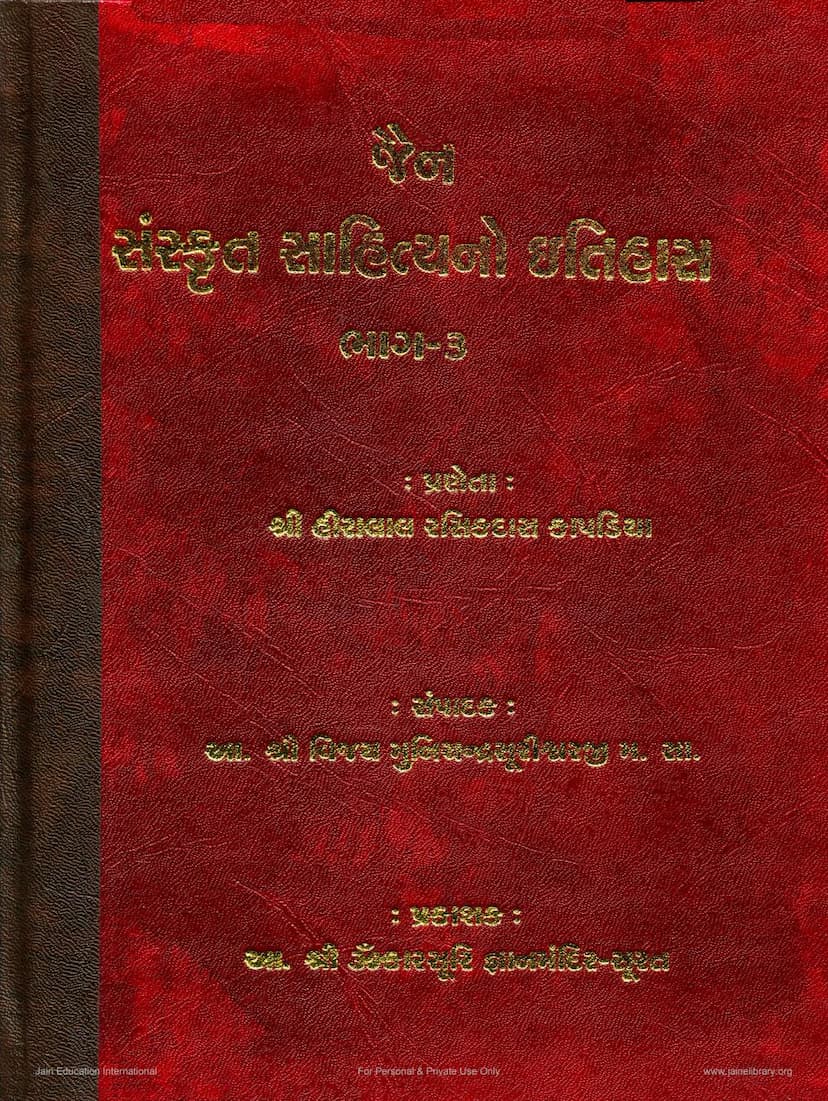Jain Sanskrit Sahityano Itihas Part 03
Added to library: September 2, 2025

Summary
Here is a comprehensive summary in English of the Jain Sanskrit text "Jain Sanskrit Sahityano Itihas Part 03" by Munichandrasuri, focusing on the provided pages and catalog link:
Book Title: Jain Sanskrit Sahityano Itihas Part 03 (A History of the Jaina Sanskrit Literature, Volume III) Author: Hiralal Rasiklal Kapadia (as the original author) Editor: Acharya Vijay Munichandrasuri M.S. Publisher: Acharya Omkarsuri Gyan Mandir, Surat. Catalog Link: https://jainqq.org/explore/005507/1
Overall Summary:
This document, "Jain Sanskrit Sahityano Itihas Part 03," is the third volume of a comprehensive history of Jain Sanskrit literature, originally authored by Hiralal Rasiklal Kapadia and meticulously edited and republished by Acharya Vijay Munichandrasuri. This volume focuses on Religious Literature, particularly works on Philosophy, Logic, Yoga, and related disciplines.
The work aims to systematically present and analyze the vast and rich tradition of Sanskrit literature created by Jain scholars. It acknowledges the significant contributions of Jain authors in preserving and expanding philosophical and religious knowledge within the Jain tradition, often engaging with and critiquing various schools of Indian philosophy.
Key Contents and Focus Areas (Based on the provided pages):
The provided pages offer a detailed table of contents and introductory sections that outline the scope of Volume III, which is primarily dedicated to Dharmik Sahitya (Religious Literature), with a significant sub-section on Darshanik Sahitya (Philosophical Literature).
The structure and content highlighted include:
-
Introduction to Indian Philosophies (Darshan): The book begins by defining 'Darshan' and discusses the various classifications of Indian philosophical systems, both Vedic (including Sankhya, Yoga, Nyaya, Vaisheshika, Mimamsa, and Vedanta) and Nastika (Charvaka, Jain, and Bauddha). It notes the Jain contribution to philosophical discourse and the practice of analyzing and refuting opposing viewpoints.
-
Key Philosophical and Religious Branches Covered:
- Darshan Mimamsa (On Philosophical Investigations): This appears to be a major focus, discussing various philosophical works and their critiques.
- Nyaya (Logic): The text delves into Jain logic, discussing the contributions to the understanding of Pramana (means of knowledge), Nayavada (theory of perspectives), and Anekantavada (non-absolutism), referencing key works and authors like Siddhasena Divakara, Akalanka, and Vadi Devasuri.
- Yoga: The philosophical underpinnings and literature related to Yoga within the Jain tradition are explored, discussing the derivation of the term 'Yoga' and its various interpretations, including Patanjali's Yoga Sutras and Jain philosophical interpretations of spiritual progress and liberation.
- Charanakramananuyoga (On Conduct and Practice): This section likely covers literature related to Jain ethics, rituals, and practices, mentioning works like Ratnakarakanda Shravakachara.
- Mantra Shastra and Kalpa: The volume also addresses literature related to mantras, tantras, and ritualistic texts known as Kalpas. It touches upon the historical development and the nature of these texts.
- Anushthan Vidhi (On Ritualistic Procedures): This section covers the practical aspects of Jain rituals and practices.
- Khandan-Mandan (Rejoinders and Refutations): The text examines literature that engages in dialectical discussions and refutations of non-Jain philosophical viewpoints, as well as internal debates within Jainism.
- Commentaries on Prakrit Works and Descriptions of Jain Texts: It includes information on Sanskrit commentaries on Prakrit Jain literature.
- Jain Interpretations of Non-Jain Texts: The work also covers instances where Jain scholars wrote commentaries or interpretations on texts from other Indian philosophical traditions.
- Epigraphy and Inscriptions: Sections are dedicated to literature related to inscriptions and engraved texts, highlighting their historical significance.
-
Editor's Contribution: Acharya Vijay Munichandrasuri's role as editor is highlighted. He preserved Kapadia's original text while adding supplementary details and corrections within square brackets
[]where necessary, ensuring the accuracy and completeness of the republished work. -
Objective of the Republication: The preface expresses the joy in republishing these valuable volumes, which had become rare, to aid researchers and scholars in understanding the history of Jain Sanskrit literature.
Key Takeaways from the Introductory and Content Pages:
- Scholarly Rigor: The text demonstrates a deep dive into the subject, classifying literature, discussing authors, their periods, and the philosophical nuances of various Jain traditions.
- Comprehensive Coverage: Volume III aims to cover a wide spectrum of Jain Sanskrit literature, focusing on its philosophical and religious aspects, which form a significant part of the Jain intellectual heritage.
- Historical Context: The editor and author's efforts are aimed at making this extensive historical and literary information accessible to a wider audience of scholars and enthusiasts.
- Structure: The book is organized into numerous chapters (indicated by chapter numbers like 36, 37, 38, etc.) that systematically categorize and discuss different literary works and philosophical schools. The table of contents further details the specific topics within each chapter, providing a roadmap of the volume's content.
In essence, "Jain Sanskrit Sahityano Itihas Part 03" is a scholarly endeavor to catalog, analyze, and present the vast philosophical and religious literature of Jainism in Sanskrit, making it a crucial resource for anyone studying Jainism, Indian philosophy, and religious literature.